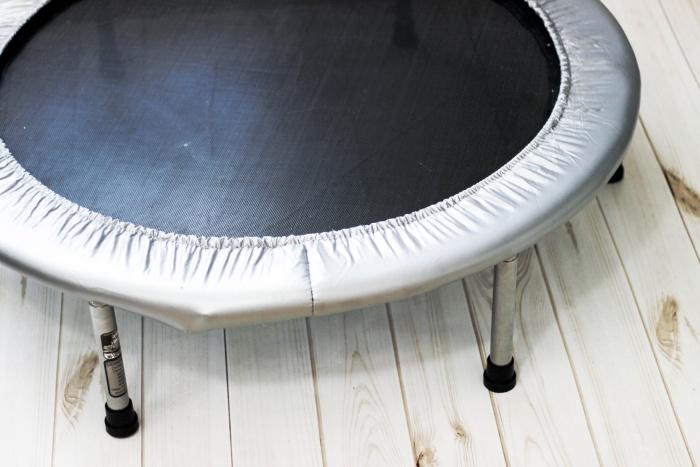Rebounding refers to the use of a small trampoline for exercise and health purposes. It is low impact and suitable for all fitness levels. It offers a wide array of benefits such as:
-
- Increased lymphatic drainage
- Stronger immune system
- Increased balance
- Better digestion
- Improved circulation and blood flow
- Low impact strength training
- Stronger bones
The trampoline was first invented in 1936 by George Nissen and two years later a smaller personal sized version was created. It wasn’t actually patented until 1975. Just a few years after being patented, the small rebounder trampoline gained notable popularity during the 1980s. This is when NASA used rebounding to help astronauts recover and readjust after returning to Earth. Since Astronauts lose around 15% of their muscle mass within 14 days of being in space, rebounding was a gentle way for them to recover and rebuild muscle.
Since rebounding is beginner-friendly, low impact and fun, it’s kind of hard to make excuses not to give it a try. Did I also mention that a small trampoline hardly takes up any space so you can do it right in the living room while binge-watching your latest obsession. Our favorite beginner rebounder is THIS ONE!
Increased lymphatic drainage
The lymphatic system is a network of organs, vessels, nodes, and a tube-like network that runs through the entire body. The purpose of this system is to remove waste, by-products, toxins and harmful cells via filtration points. If your lymphatic system is bogged down, slow or blocked then you probably experience more frequent bouts of the cold or flu but it can lead to more serious issues like cancer or Alsheimer’s.

There are a few ways you can keep your lymphatic system running efficiently and one is rebounding. Bouncing up and down helps to clear away blockages, speeds up slowed systems and forces vessels to open and lymphatic fluid to purge. This is a wonderful way to clean your system and help maintain a healthy immune system.
Increased Balance
Balance and coordination are more important than you realize. In fact, you probably take yours for granted without even realizing it. Walking, climbing stairs, stepping up onto something, dancing, sitting in a chair, getting out of bed, playing sports, and exercising are all general activities that require balance and coordination.
Rebounding improves posture and forces you to stabilize yourself on an uneven surface. It also engages the core and back muscles. The more you rebound the more advanced your motor skills become and the more stamina you will have both on the trampoline and in your general daily life. On top of that, the older we get the more challenging balance and coordination becomes. Our skills seem to decrease and it is important to incorporate exercises to maintain these basic motor skills. It will prevent accidental trips and falls which can put us at risk for serious injury.
Better Digestion
Rebounding increases your heart rate which stimulates blood flow and circulation. This increase in fresh blood and oxygen activates the digestive system and eliminates sluggish buildup. Furthermore, digestive issues such as constipation, gas, and stomach cramps are soothed by this added stimulation. People who regularly exercise and incorporate activities such as rebounding have fewer or none of these types of digestive problems. Our all-around favorite rebounder is THIS ONE!
Circulation and Blood Flow
Any exercise or strenuous activity will increase your heart rate and cause blood to move through your body more quickly. This helps to flush out arteries and allow fresh oxygen and nutrients to flow in. Heart disease, stroke, and heart failure are all directly connected to the circulation, blood flow, and cardiovascular health. Rebounding helps prevent plaque buildup in arteries by forcing excess debris into the blood where it can be removed.
Low Impact Strength Training
If you have ever jumped rope then you know what it feels like to vertically jump and fully absorb the shock as you land. The wonderful aspect of rebounding is that you are working the same muscles but not absorbing any of the shock. It is easier on ankles, knees, and hips when compared to traditional jump roping. As you jump on a rebounder you are forcing yourself to engage all major muscle groups to sustain motion, balance, and momentum. You can even add some dumbbells to your routine to challenge your arm strength and burn more calories.
Strong Bones
The vertical up and downward force of rebounding applies pressure to your skeletal system. In order for bones to rebuild and become denser, they need to be put under pressure. Your bones respond to this pressure by becoming stronger. Rebounding offers a low impact and a beginner-friendly way to increase bone density. It takes time and regular practice but rebounding is amazing for injury recovery or anyone susceptible to osteoporosis.
Tips
To get the most out of rebounding aim for 15-minute sessions 3-5 times a week. If it’s more convenient, you can even split that up into 2-3 mini sessions a day. Make sure you wear loose-fitting clothing so that you aren’t restricting lymphatic drainage. Try to maintain a regular routine and practice consistently. This is how you will maximize results and improve your health.



